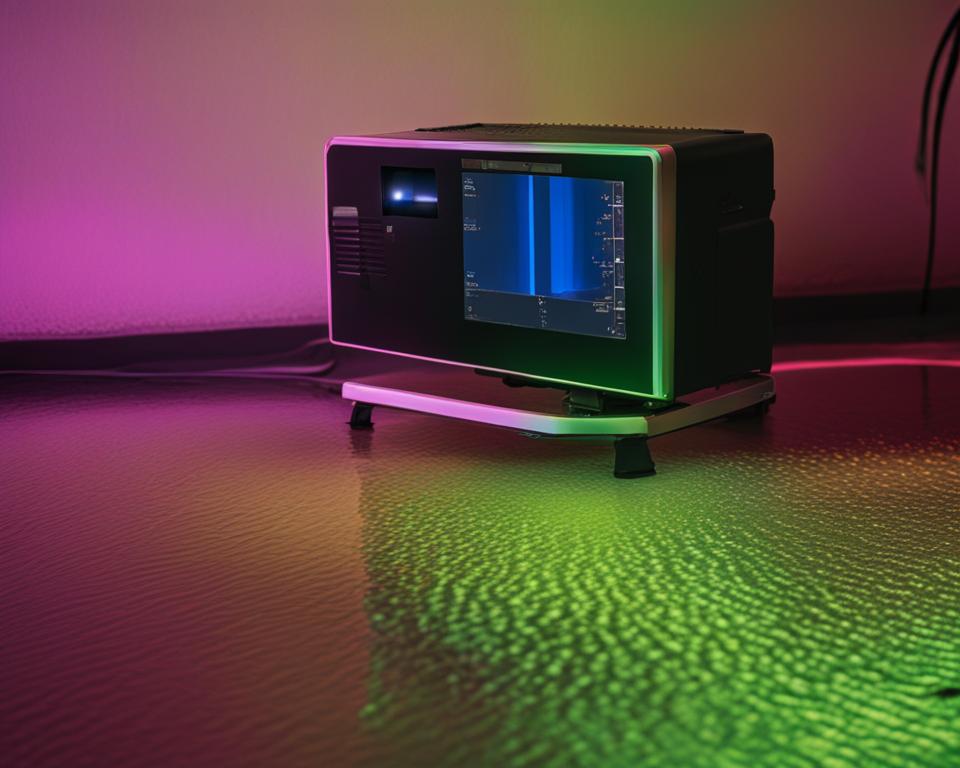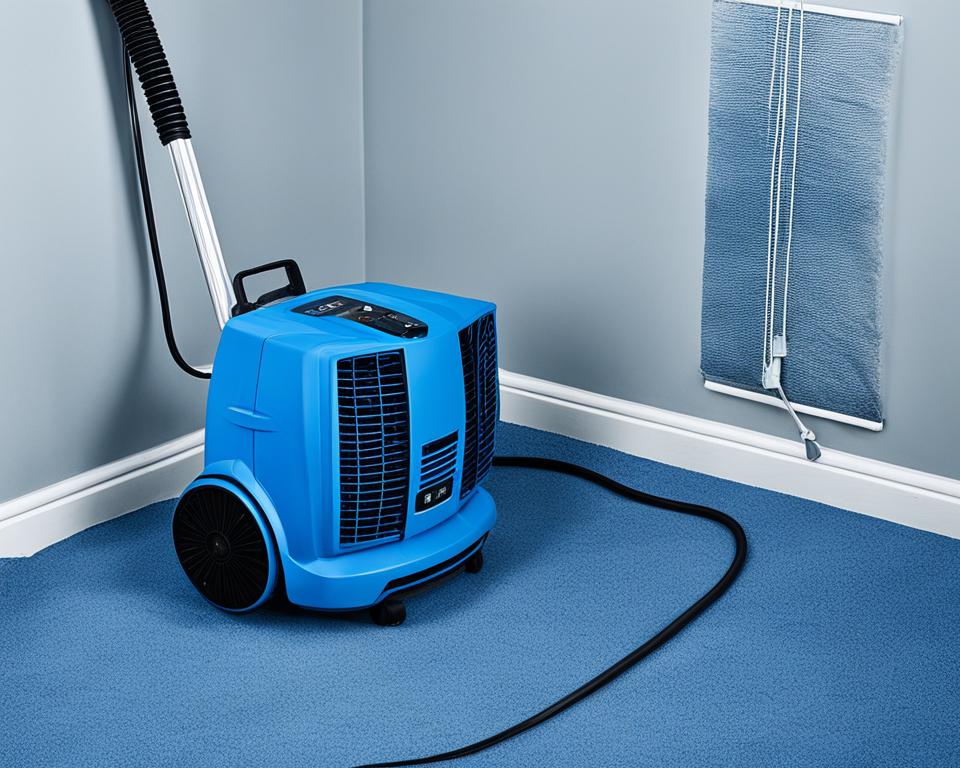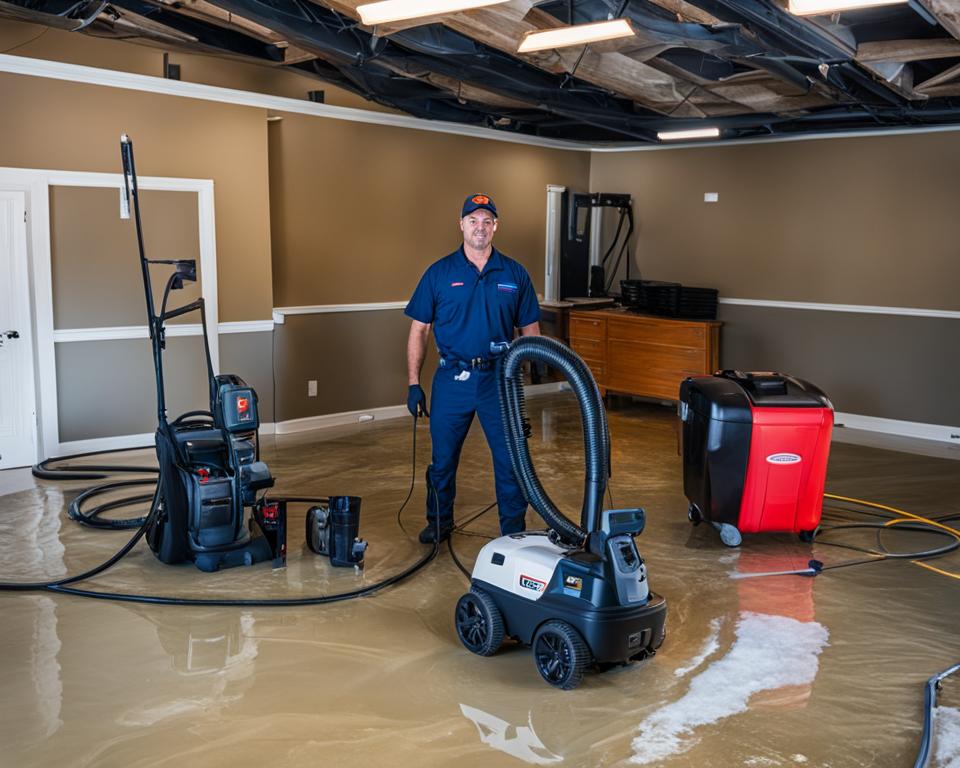When it comes to water damage restoration, having the appropriate equipment is crucial for effectively restoring properties affected by floods and leaks. By utilizing the right tools, you can expedite the cleanup process, minimize further damage, and ensure a thorough restoration. In this article, we will explore the essential equipment needed for water damage restoration and their importance in the restoration process.
Key Takeaways:
- Water extractors or wet-dry vacuums help in removing water from affected areas.
- Moisture meters and hygrometers are used to measure the severity of water damage and monitor moisture levels.
- IR cameras are effective in detecting hidden moisture and identifying potential water damage areas.
- Dehumidifiers and air movers are crucial for drying out affected areas and preventing mold growth.
- Air filtration devices assist in improving air quality by removing pollutants and harmful particles.
- Self-propelled dump containers are useful for removing excess debris and transporting equipment.
Water Extractors or Wet-Dry Vacuums
When it comes to water damage restoration, one of the most essential pieces of equipment is a water extractor or a wet-dry vacuum. These powerful tools are designed to effectively remove water from affected areas, aiding in the restoration process. Whether you are dealing with a small leak or a massive flood, having a reliable water extractor or wet-dry vacuum is crucial.
Investing in a high-quality water extractor is recommended for long-term use, as it provides better suction power and durability. However, if you are just starting out or working on a tight budget, a wet-dry vacuum from a local hardware store can suffice temporarily. While it may not have the same level of power and features as a specialized water extractor, it can still effectively remove water from various surfaces and materials.
When choosing a water extractor or wet-dry vacuum, consider factors such as suction power, tank capacity, hose length, and additional features like HEPA filters or automatic shut-off functions. These features can enhance the effectiveness and efficiency of the equipment, allowing you to extract water more quickly and thoroughly.
The Benefits of Water Extractors or Wet-Dry Vacuums:
- Efficiently remove water from carpets, flooring, upholstery, and other surfaces.
- Prevent further water damage and potential mold growth.
- Save time and effort compared to manual water extraction methods.
- Reduce the risk of structural damage caused by standing water.
- Improve the overall drying process, speeding up the restoration timeline.
Having a water extractor or a wet-dry vacuum is a fundamental step in water damage restoration. Whether you are a professional restoration company or an individual homeowner dealing with a water-related disaster, investing in this equipment will significantly enhance your ability to recover and restore affected areas.
Image:
Comparison Table: Water Extractors vs. Wet-Dry Vacuums
| Feature | Water Extractors | Wet-Dry Vacuums |
|---|---|---|
| Suction Power | Higher suction power for faster water extraction | Lower suction power, but still effective for most water extraction tasks |
| Tank Capacity | Larger tanks for extended use without frequent emptying | Smaller tanks that require more frequent emptying |
| Additional Features | May have specialized attachments, HEPA filters, automatic shut-off | Basic attachments, may lack specialized features |
| Price Range | Higher price range due to advanced features and durability | Lower price range, affordable for temporary use or smaller-scale projects |
Moisture Meters and Hygrometers
When it comes to water damage restoration, accurate measurement of moisture levels is crucial. That’s where moisture meters and hygrometers come into play. These essential tools allow professionals to assess the severity of water damage and monitor moisture levels before and after restoration tasks.
Investing in high-quality moisture meters and hygrometers ensures accurate readings, enabling restoration teams to make informed decisions and take appropriate action. These tools provide valuable data that helps determine the extent of damage, track the progress of drying efforts, and ensure the affected areas are thoroughly dry.
Moisture meters are designed to measure moisture content in different materials, such as wood, drywall, and concrete. By detecting hidden moisture, professionals can identify areas that may require additional attention and prevent further damage, such as mold growth.
Hygrometers, on the other hand, measure the relative humidity in the air. Monitoring humidity levels is essential for creating optimal drying conditions during the restoration process. By maintaining the right humidity levels, professionals can accelerate the drying process and prevent the growth of mold and bacteria.
Choosing reliable brands and models of moisture meters and hygrometers is crucial for accurate readings and long-term durability. Here are some key features to consider when investing in these tools:
- Accuracy and calibration: Ensure the meters are calibrated properly and provide accurate readings.
- Measurement range: Check if the meters can measure a wide range of moisture levels, allowing you to handle different types of water damage scenarios.
- Functionality: Look for features like backlighting, data recording capabilities, and customizable settings to suit your specific needs.
- Portability and durability: Opt for lightweight, portable models that can withstand the rigors of a restoration environment.
By utilizing moisture meters and hygrometers, professionals can effectively assess water damage and monitor the progress of restoration efforts. These tools provide valuable insights that enable accurate decision-making and ensure thorough drying, ultimately leading to successful water damage restoration.
| Advantages of Moisture Meters | Advantages of Hygrometers |
|---|---|
|
|
IR Cameras
IR cameras play a crucial role in water damage restoration by detecting hidden moisture and identifying areas of potential water damage. These cameras use infrared technology to capture thermal images, allowing restoration professionals to detect moisture that may be lurking behind walls, floors, or other hidden areas.
Maintaining the integrity and safety of the property is essential during the restoration process, and IR cameras can provide valuable insights to help achieve this goal. By detecting and addressing hidden moisture, restoration professionals can mitigate further damage and prevent potential mold growth.
While high-end IR cameras can be expensive, investing in a mid-range IR camera is sufficient for starting a water damage restoration business, especially for those on a budget. These cameras still offer reliable performance and accurate results, making them a cost-effective option without compromising on quality.
In addition, some mid-range IR cameras also offer features such as built-in moisture measurement capabilities and data logging, allowing for easier documentation and analysis of moisture levels. This can be especially helpful when providing detailed reports to clients or insurance companies.

Having reliable IR cameras in your toolkit can greatly enhance the efficiency and effectiveness of water damage restoration projects. The ability to identify and address hidden moisture not only ensures the thoroughness of the restoration process but also instills confidence in clients that their property is being properly cared for.
By making use of advanced technology such as IR cameras, restoration professionals can deliver high-quality results while prioritizing the health and safety of both the property and its occupants.
Dehumidifiers and Air Movers
In the water damage restoration process, dehumidifiers and air movers play a crucial role in drying out affected areas and preventing mold growth. These essential equipment pieces work together to create the optimal conditions for efficient restoration.
Dehumidifiers are designed to extract excess moisture from the air, effectively reducing humidity levels and accelerating the drying process. By removing moisture, dehumidifiers help prevent mold and mildew growth, protecting both the structure and the air quality of the affected area.
Air movers, also known as fans or blowers, work in tandem with dehumidifiers to enhance airflow and promote evaporation. These powerful machines circulate the air, facilitating the drying process by increasing the rate at which moisture evaporates from surfaces.
To achieve optimal results, it is recommended to maintain a proper ratio between dehumidifiers and air movers. A commonly suggested ratio is to have 1 XL dehumidifier or 2 large dehumidifiers for every 7-8 air movers. This balance ensures that the dehumidifiers can effectively remove the moisture extracted by the air movers, creating an efficient and controlled drying environment.
When selecting dehumidifiers and air movers for your water damage restoration business, it is important to choose reliable brands that offer durability and effective performance. Trusted brands have a track record of providing high-quality equipment that withstands heavy use and delivers consistent results.
Investing in top-notch dehumidifiers and air movers not only boosts your restoration efficiency but also contributes to the overall success of your business. By providing fast and thorough drying, these equipment pieces minimize the risk of secondary damage, reduce downtime, and ensure customer satisfaction.

With the combination of dehumidifiers and air movers, you can effectively dry out water-damaged areas, prevent mold growth, and restore the affected space to its pre-damage condition.
Air Filtration Devices
Air filtration devices play a crucial role in improving air quality after water damage has occurred. These devices effectively remove pollutants and harmful particles, creating a healthier environment for restoration work. It is highly recommended to include air filtration devices as part of your water damage restoration equipment.
When determining the quantity of air filtration devices needed, it is important to consider the size of the dehumidifiers used. As a guideline, it is recommended to have one 500 CFM air filtration device for every XL dehumidifier or 2 large dehumidifiers. This ensures optimal air purification and maintains a safe working environment.
| Benefits of Air Filtration Devices |
|---|
| 1. Removes allergens and irritants from the air, promoting cleaner and healthier breathing. |
| 2. Reduces the risk of respiratory issues for workers and occupants. |
| 3. Helps prevent the spread of mold spores and other contaminants. |
| 4. Eliminates odors caused by water damage, creating a fresher environment. |
| 5. Improves overall indoor air quality, ensuring a safe and comfortable space. |
By incorporating air filtration devices into your water damage restoration equipment, you can provide a comprehensive solution for improving air quality. This not only enhances the restoration process but also contributes to the well-being of both workers and affected individuals.
Self-Propelled Dump Containers
When it comes to water damage restoration, the efficient removal of debris and damaged items is crucial for a successful cleanup process. That’s where self-propelled dump containers come in. These innovative containers are specifically designed to simplify the removal of excess waste from the job site, making the restoration process faster and more effective.
One of the key advantages of self-propelled dump containers is their versatility. Not only can they be used to dispose of debris, but they can also serve as a convenient means of transporting equipment between different floors of a building. This feature saves time and effort for restoration professionals, allowing them to focus on the task at hand without unnecessary interruptions.
Another benefit of using self-propelled dump containers is their efficiency. These containers are equipped with durable wheels and a powerful motor, enabling them to move easily over various surfaces and carry heavy loads. This makes them ideal for handling large amounts of debris and damaged materials in a quick and effortless manner.
In addition to their practicality, self-propelled dump containers are also designed with safety in mind. They are equipped with features such as sturdy handles and reliable braking systems, ensuring stability and secure operation during the transportation and dumping process. This ensures the well-being of restoration professionals and minimizes the risk of accidents or injuries.
FAQ
What kind of equipment do I need for water damage restoration?
To effectively recover from floods and leaks, you will need water extractors or wet-dry vacuums, moisture meters, hygrometers, IR cameras, dehumidifiers, air movers, air filtration devices, and self-propelled dump containers.
Are water extractors or wet-dry vacuums necessary for water damage restoration?
Yes, water extractors or wet-dry vacuums are essential for removing water from affected areas. It is recommended to invest in a high-quality water extractor, but a temporary solution can be a wet-dry vacuum from a local hardware store.
What are moisture meters and hygrometers used for in water damage restoration?
Moisture meters and hygrometers are used to measure the severity of water damage and monitor moisture levels before and after restoration tasks. It is recommended to invest in high-quality moisture meters and hygrometers for accurate readings.
How are IR cameras helpful in water damage restoration?
IR cameras are used to detect hidden moisture and identify areas of potential water damage. A mid-range IR camera will suffice for starting a water damage restoration business.
Why do I need dehumidifiers and air movers for water damage restoration?
Dehumidifiers and air movers are crucial for drying out affected areas and preventing mold growth. It is important to choose reliable brands for dehumidifiers and air movers.
What role do air filtration devices play in water damage restoration?
Air filtration devices help improve air quality by removing pollutants and harmful particles after water damage has occurred. It is recommended to have one 500 CFM air filtration device for every XL dehumidifier or 2 large dehumidifiers.
Why should I consider using self-propelled dump containers?
Self-propelled dump containers are useful for removing excess debris and damaged items from the job site during water damage restoration. They can also be used to transport equipment between floors, providing convenience and efficiency.

Leave a Reply